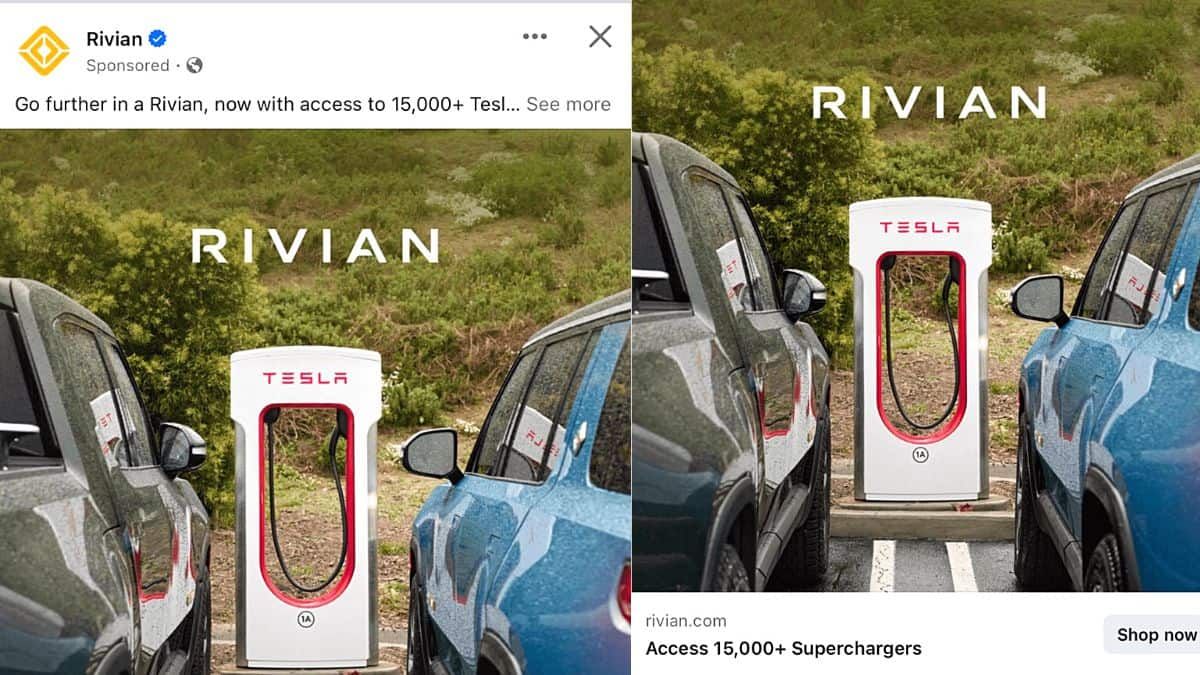Today I came across this unique advertising, which Rivian is doing for potential Rivian buyers, but it's also free advertising for Tesla.
Rivian is running free advertising for Tesla. More precisely, Rivian is running paid ads on Facebook highlighting that Rivian EV owners can now access over 15,000 Tesla Superchargers. This is precisely why it appears that Tesla may be undervalued and the market will probably need to catch up to this development in the industry as more EV producers adapt to NACS charging standards, which EV users have demanded for a long time.
Rivian's ad reads, "Go further in a Rivian, now with access to 15,000+ Tesla Superchargers."
By the way, look in the picture. See that the two Rivianvehicles in the picture are blocking all of the chargers, but are not plugged in. Rivian could do better to have them pictured plugged in, kind of "in the action" of charging from a Tesla Supercharger.
Yet, having said this, I think what Rivian is doing is a win-win marketing for both Tesla and Rivian. I am expecting the other car companies that have adapted to Tesla's NACS charging standard follow the suit and reveal similar ads. This is a great dual marketing.
Tesla's long game has always been the infrastructure.
In the realm of electric vehicles, Tesla has undeniably set itself apart not just with innovative technology but also with a strategic approach to infrastructure development. While the allure of cutting-edge electric powertrains and sleek design may initially draw consumers to Tesla vehicles, it's the company's long-term vision for a comprehensive charging network that truly distinguishes it from competitors. Let's delve into why Tesla's long game has always revolved around the infrastructure of supercharging.
Now let's look into Tesla's supercharging infrascture and understand its signifiance.
1. Overcoming Range Anxiety:
One of the primary barriers to widespread EV adoption has been range anxiety—the fear of running out of charge before reaching a destination. Tesla recognized this concern early on and addressed it by building a robust network of Superchargers strategically placed along major travel routes. This infrastructure provides Tesla drivers with peace of mind, knowing they can quickly recharge their vehicles during long journeys.
2. Enhancing Convenience and Accessibility:
Unlike traditional gas-powered vehicles, EVs require charging rather than refueling. Tesla's Supercharger network offers unparalleled convenience, with stations typically located near amenities such as restaurants, shopping centers, and rest areas. This strategic placement not only makes charging more accessible but also encourages drivers to patronize nearby businesses while their vehicles recharge.
3. Promoting EV Adoption:
By prioritizing the expansion of its Supercharger network, Tesla aims to accelerate the transition to sustainable transportation. The widespread availability of fast, reliable charging infrastructure alleviates concerns about EV practicality and encourages more consumers to make the switch from internal combustion engine vehicles. In essence, Tesla's investment in Superchargers serves as a catalyst for broader EV adoption.
But you know, Tesla's supercharging infrastructure has evolved.
Tesla recognized the importance of charging infrastructure from the outset, with the first Supercharger stations deployed in 2012. These stations initially catered to long-distance travel, allowing Tesla drivers to traverse vast distances with minimal downtime. As demand for EVs grew, so too did the Supercharger network, expanding both domestically and internationally.
Tesla's commitment to innovation extends beyond vehicle technology to encompass charging infrastructure. The company has continually refined its Supercharger technology, introducing faster charging speeds and more efficient station designs. Notably, the introduction of V3 Superchargers marked a significant leap forward, offering peak charging rates of up to 250 kW and reducing charging times substantially.
Tesla has integrated its Supercharger network with renewable energy sources, such as solar and battery storage. This approach aligns with the company's broader sustainability goals and reduces reliance on the grid. By leveraging clean energy to power its charging stations, Tesla further enhances the environmental benefits of EV ownership.
Why Tesla's Supercharging Infrastructure Matters?
With so many car companies adapting to NACS and with today's Rivian ad Tesla proved that its focus on building a robust Supercharger network is not merely a short-term strategy but a foundational pillar of its long-term success. Here's why it matters:
1. Competitive Advantage: Tesla's extensive Supercharger network provides a significant competitive advantage over other EV manufacturers. While rival companies are striving to develop their charging infrastructure, Tesla's head start and ongoing investment give it a substantial lead in the market.
2. Customer Loyalty and Satisfaction: The reliability and convenience of Tesla's Superchargers contribute to high levels of customer satisfaction and loyalty. Tesla owners enjoy the seamless charging experience and are more likely to remain brand advocates, thereby fueling further growth and market penetration.
3. Economic and Environmental Impact: A robust charging infrastructure not only benefits Tesla but also has broader economic and environmental implications. By facilitating the transition to clean transportation, Tesla's Supercharger network helps reduce greenhouse gas emissions, improve air quality, and create jobs in the renewable energy sector.
Some people look at this and say Tesla doesn't need to advertise anymore. But Rivian placed an advertisement with Tesla prominently visible in the middle. I think Tesla should do the same. This is a smart collaborative marketing strategy. In this way the potential EV buyers will get the message from both sides.
Armen Hareyan is the founder and the Editor in Chief of Torque News. He founded TorqueNews.com in 2010, which since then has been publishing expert news and analysis about the automotive industry. He can be reached at Torque News Twitter, Facebook, Linkedin, and Youtube. He has more than a decade of expertise in the automotive industry with a special interest in Tesla and electric vehicles.





